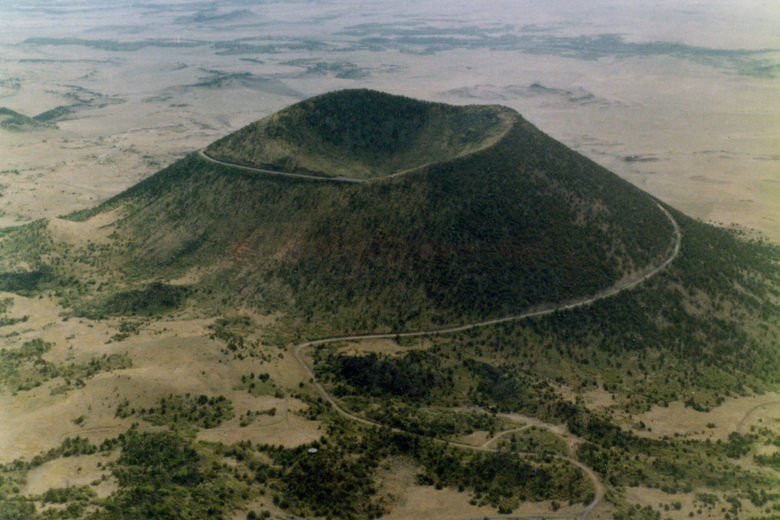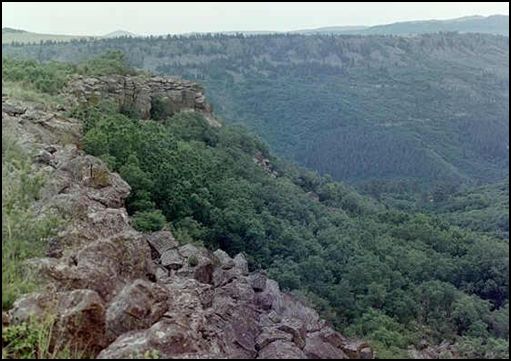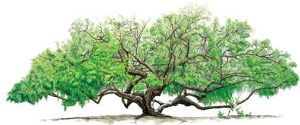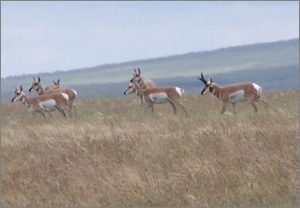Nearby Attractions

Capulin Volcano:
located in Northeastern New Mexico, was designated a U.S. National Monument on August 9, 1916. It is an example of an extinct cinder cone volcano that is part of the Raton-Clayton Volcanic Field.
located in Northeastern New Mexico, was designated a U.S. National Monument on August 9, 1916. It is an example of an extinct cinder cone volcano that is part of the Raton-Clayton Volcanic Field.

The Santa Fe National Historic Trail
crosses the five states of Missouri, Kansas, Colorado, Oklahoma, and New Mexico. You may decide to travel its entire length, or visit just one or two sites.

Sugarite Canyon State Park
Sugarite includes two lakes,Lake Dorothy and Lake Maloya, which host some of the best trout fishing in New Mexico.
Sugarite includes two lakes,Lake Dorothy and Lake Maloya, which host some of the best trout fishing in New Mexico.

The Clayton Lake State Park
dinosaur track site, has over five hundred dinosaur footprints preserved, and is one of the best-preserved and most extensive dinosaur track sites in the U.S.
Wildlife and Fauna

Kiowa Valley lies within a transition zone, from the high elevations of the Rocky Mountains to the sweeping grasslands of the Great Plains. The prevailing wind direction in this region is westerly; therefore once precipitation reaches the grasslands, there is generally only enough water to support short- (less than 2 feet, or 0.6 am) and midsize (2-4 feet, or 0.6-0.8 am) grasses. However, as the winds travel toward Capulin, they pick up more moisture and as a result deliver enough precipitation to support a few tall grass (over 5 feet, or 1.5 am) species.
Prairie
Within the monument, shortgrass prairie is dominant, with medium-sized grasses, and the three main species of tall grasses; Big Bluestem, Indiangrass, and Switchgrass,also being present. Blue grama and Sideoats grama are two dominant grasses that thrive in the monument.
 Desert plants, such as cacti and yuccas, also live on the short-grass prairie within the monument. Abundant wildflowers, such as Prickly Poppy, Indian Paintbrush, Sunflowers, and Beardlip Penstemon. The high plains of northeastern New Mexico, including Kiowa
Valley, are where shortgrass prairie and mountain forest meet. This transition between two ecosystems provides habitat for many different plants and animals.
Desert plants, such as cacti and yuccas, also live on the short-grass prairie within the monument. Abundant wildflowers, such as Prickly Poppy, Indian Paintbrush, Sunflowers, and Beardlip Penstemon. The high plains of northeastern New Mexico, including Kiowa
Valley, are where shortgrass prairie and mountain forest meet. This transition between two ecosystems provides habitat for many different plants and animals. 
Large mammals such as deer and antelope roam the plains. The combination of grassland and forest provides habitat for upland and woodland songbirds. Insects swarm at the high elevations and reptiles find homes in the rocky crevices. Warm air rising from the plains around the volcano provide thermals for many soaring birds. Turkey Vultures return to the mountain each spring. Ravens, Red-tailed and Ferruginous Hawks play throughout the year and Northern Harriers are common over the plains all winter.
Prairie grasslands provide habitat for upland birds such as meadowlarks, roadrunners, and sparrows. The pinyon/juniper woodlands are home to jays, towhees, and woodpeckers.
Astronomy & Stargazing
The ranch sits at 7000ft with little humidity and virtually no lights. This makes it the perfect place for observing. While the Okie-Tex Star Party is nationally famous for its dark skies location in the Oklahoma Panhandle. Kiowa Valley Ranch is over 2000’ higher with lower humidity. It is nearly a perfect place to enjoy the skies.
A “natural lightscape,” such as a dark night sky, is an environment that is undisturbed by light and air pollution. Dark night skies have natural, cultural, and scenic importance. Wildlife is impacted by light pollution because animals often depend on darkness in order to hunt, conceal their location, navigate, or reproduce. For nocturnal animals, light pollution also means habitat disruption. Additionally, many species have far more sensitive vision than humans. Plants are affected by artificial light because it disrupts their natural cycles. Dark night skies are also culturally important because they are a resource common to all cultures on Earth, and are a metaphor for countless myths and religions. They have inspired innumerable works of art, literature, and connections to the cosmos.
Natural lightscapes, including dark night skies, are a scenic resource integral to many people’s Yosemite experience. Currently, two-thirds of Americans cannot see the Milky Way from their backyard, and if current light pollution trends continue, there will be almost no dark skies left in the contiguous United States by 2025.
BOOK YOUR STAY TODAY
© Kiowa Valley Ranch Camp 2026